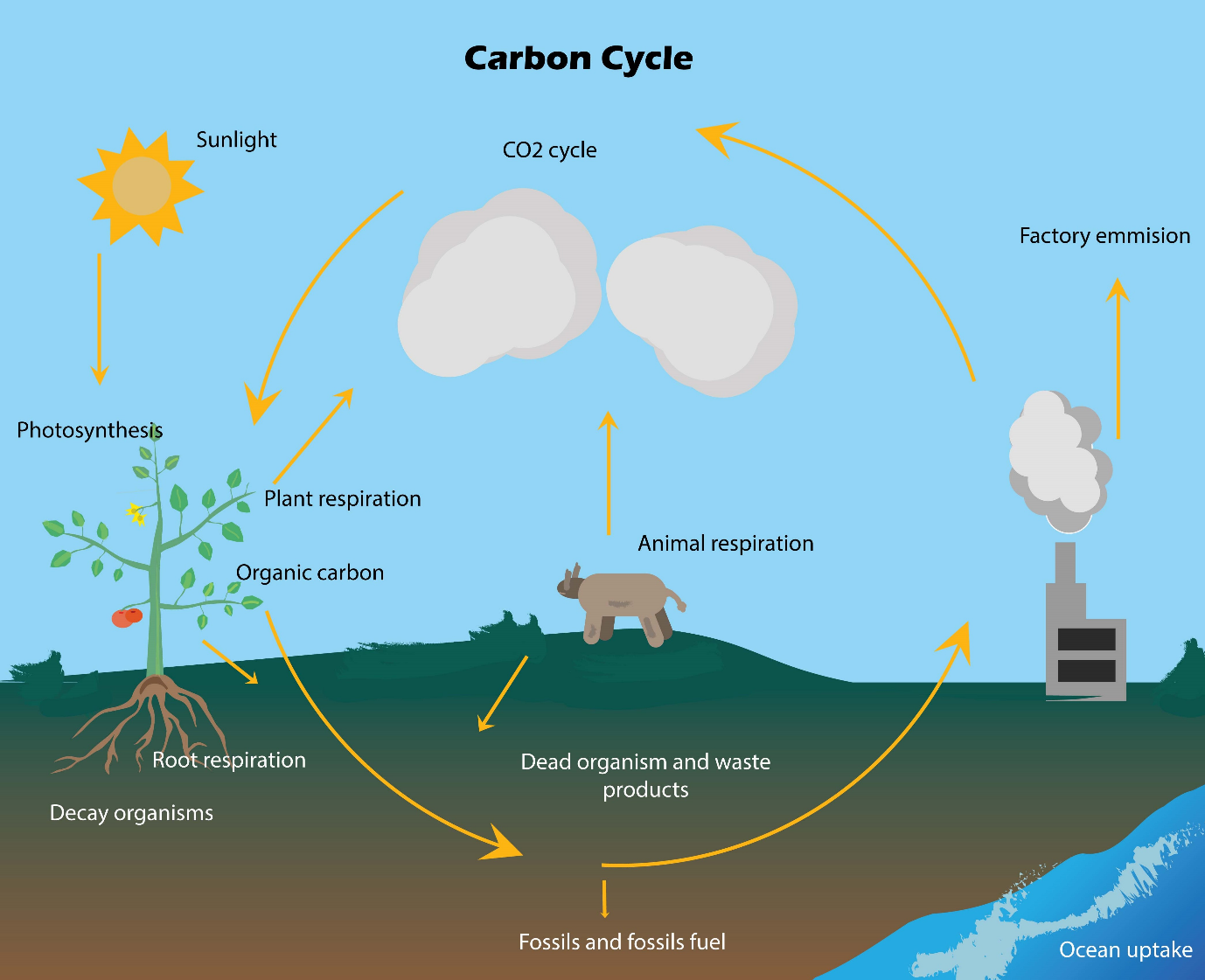Answer
396.9k+ views
Hint: The carbon cycle includes all the processes that consume or release carbon compounds from/ to the environment. The step that is not involved among the following is related transport of substances through xylem tissue in plants.
Complete answer:
Carbon is one of the most important components of biological compounds as well as a major component of many minerals like the limestone. The carbon cycle describes the movement of carbon in the environment as it is recycled and reused throughout the biosphere. It also describes the long- term processes of carbon sequestration and carbon release to and from the carbon sinks.
In the atmosphere, carbon dioxide and methane are the most common forms of carbon. Of these gases, carbon dioxide is consumed from the atmosphere in the process of photosynthesis, while it is released to the atmosphere as a by- product of respiration in all the organisms. Thus, photosynthesis and respiration are an integral part of the carbon cycle.
Burning of fossil fuels results in the formation of smoke and gases such as carbon monoxide and carbon dioxide, thus adding to the carbon in the atmosphere. So, the burning of fossil fuels also plays a role in the carbon cycle.
Transpiration however is primarily a process that is used for the gaseous exchange and release of water vapors into the atmosphere and thus not playing any direct role in the carbon cycle.

So, the answer is, “Transpiration”.
Additional Information:
The carbon cycle which was first discovered by Antoine Lavoisier and Joseph Priestly and later popularized by Humphry Davy. The global carbon cycle is usually divided into the major reservoirs of carbon that are interconnected by pathways of exchange. The reservoirs are:
- The atmosphere - The terrestrial biosphere - The oceans, including dissolved inorganic carbon and the biotic and abiotic marine biota - The sediments, which include fossil fuels, freshwater systems, and non- living organic compounds - The Earth's interior, i.e. its mantle and crust
Note: Along with the carbon cycle, the water cycle and the nitrogen cycle are the sequences of events that are the keys to make Earth capable of sustaining life. The water cycle is the cycle that comprises the evaporation of water from various sources to its replenishment through the rains. The nitrogen cycle is also a biogeochemical process in which nitrogen is converted to multiple chemical forms by the interaction with environmental factors and the organisms.
Complete answer:
Carbon is one of the most important components of biological compounds as well as a major component of many minerals like the limestone. The carbon cycle describes the movement of carbon in the environment as it is recycled and reused throughout the biosphere. It also describes the long- term processes of carbon sequestration and carbon release to and from the carbon sinks.
In the atmosphere, carbon dioxide and methane are the most common forms of carbon. Of these gases, carbon dioxide is consumed from the atmosphere in the process of photosynthesis, while it is released to the atmosphere as a by- product of respiration in all the organisms. Thus, photosynthesis and respiration are an integral part of the carbon cycle.
Burning of fossil fuels results in the formation of smoke and gases such as carbon monoxide and carbon dioxide, thus adding to the carbon in the atmosphere. So, the burning of fossil fuels also plays a role in the carbon cycle.
Transpiration however is primarily a process that is used for the gaseous exchange and release of water vapors into the atmosphere and thus not playing any direct role in the carbon cycle.

So, the answer is, “Transpiration”.
Additional Information:
The carbon cycle which was first discovered by Antoine Lavoisier and Joseph Priestly and later popularized by Humphry Davy. The global carbon cycle is usually divided into the major reservoirs of carbon that are interconnected by pathways of exchange. The reservoirs are:
- The atmosphere - The terrestrial biosphere - The oceans, including dissolved inorganic carbon and the biotic and abiotic marine biota - The sediments, which include fossil fuels, freshwater systems, and non- living organic compounds - The Earth's interior, i.e. its mantle and crust
Note: Along with the carbon cycle, the water cycle and the nitrogen cycle are the sequences of events that are the keys to make Earth capable of sustaining life. The water cycle is the cycle that comprises the evaporation of water from various sources to its replenishment through the rains. The nitrogen cycle is also a biogeochemical process in which nitrogen is converted to multiple chemical forms by the interaction with environmental factors and the organisms.
Recently Updated Pages
How do you arrange NH4 + BF3 H2O C2H2 in increasing class 11 chemistry CBSE

Is H mCT and q mCT the same thing If so which is more class 11 chemistry CBSE

What are the possible quantum number for the last outermost class 11 chemistry CBSE

Is C2 paramagnetic or diamagnetic class 11 chemistry CBSE

What happens when entropy reaches maximum class 11 chemistry JEE_Main

Calculate the volume occupied by 88 gram of CO2 at class 11 chemistry CBSE

Trending doubts
Difference between Prokaryotic cell and Eukaryotic class 11 biology CBSE

Difference Between Plant Cell and Animal Cell

Fill the blanks with the suitable prepositions 1 The class 9 english CBSE

Change the following sentences into negative and interrogative class 10 english CBSE

Fill the blanks with proper collective nouns 1 A of class 10 english CBSE

What organs are located on the left side of your body class 11 biology CBSE

Write an application to the principal requesting five class 10 english CBSE

a Tabulate the differences in the characteristics of class 12 chemistry CBSE

Write a letter to the principal requesting him to grant class 10 english CBSE



